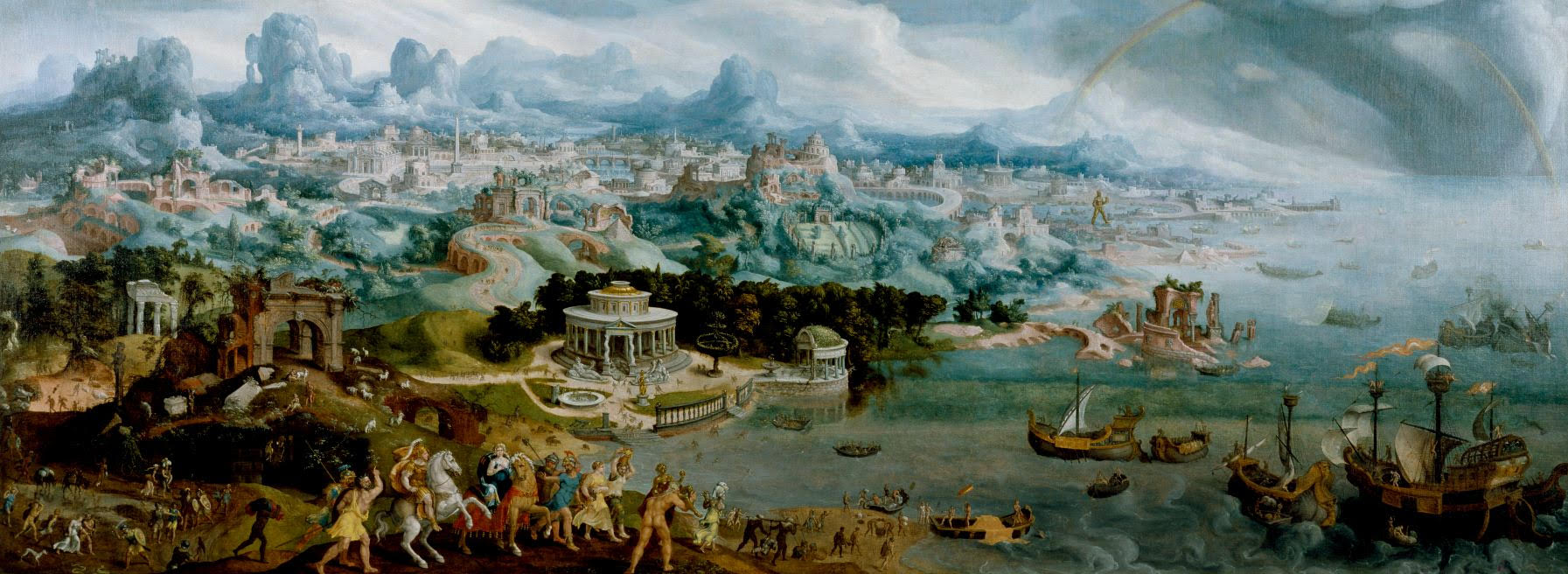
Seven Wonders as background for Maerten van Heemskerck’s Abduction of Helen by Paris
We’re drawing close to the end of 2015 and, like many people do, I’ve starting thinking back over some of the things we’ve seen in the media over the past twelve months.
The world is mad, there’s no doubt about it, and prayers for world peace and goodness are more needed than ever.
Chaos seems to rule much of the world, and this past year, even history and archaeology did not escape unscathed. With the blatant destruction of sites such as Hatra and Nineveh, Palmyra and now possibly sites in Libya, we are seeing things that have stood for thousands of years turn to dust.
It’s been a sad year for the past, and this makes our future look bleaker in some respects. Needless to say, the human suffering is on a whole other level…
But I don’t want to cast a shadow on the time of the Solstice, the time of the Sun’s rebirth.
Instead, I want to take a look at some of the shining lights of creation and human achievement in the past. Just because something is gone, does not mean it doomed to be forgotten.
There are certain ancient sites that have captivated humans since their creation, and inspired artistic and architectural traditions for centuries. They are beacons, they are supreme examples of will and imagination, and they are pure magnificence.
They are The Seven Wonders of the Ancient World.
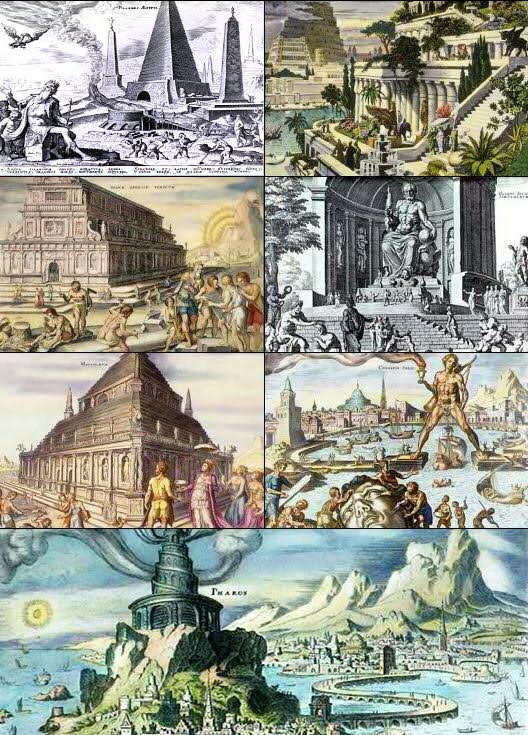
The Seven Wonders of the Ancient World by Maerten van Heemskerck
The mere mentioned of the Seven Wonders stirs a longing in me for some vague but powerful reason. Perhaps it’s because they remind me of bygone ages of which I have often daydreamed?
The truth is, I’m not alone in this feeling, this fascination with a list of monuments created so long ago. The Seven Wonders have captured the imagination of people since the Hellenistic age. Sure, the list might have changed a little, but its celebration of artistic and architectural inspiration and achievement most certainly has not.
Where did the list come from?
Consensus points to two figures of the ancient world who may have compiled the most popular list: Philo of Byzantium and Antipater of Sidon.
Philo of Byzantium was a 3rd century B.C. resident of Alexandria who wrote a compendium of mechanics, and Antipater of Sidon was a Greek poet of the 2nd century B.C.
It is no coincidence that the two men were Greek. After the campaigns of Alexander, and the fall of the Persian Empire, the East opened up and Hellenic people and ideas spread far from the homeland. Greeks had been living in Egypt and Persia for a long time already by then, but now they could move about more freely and that meant one thing: tourism!
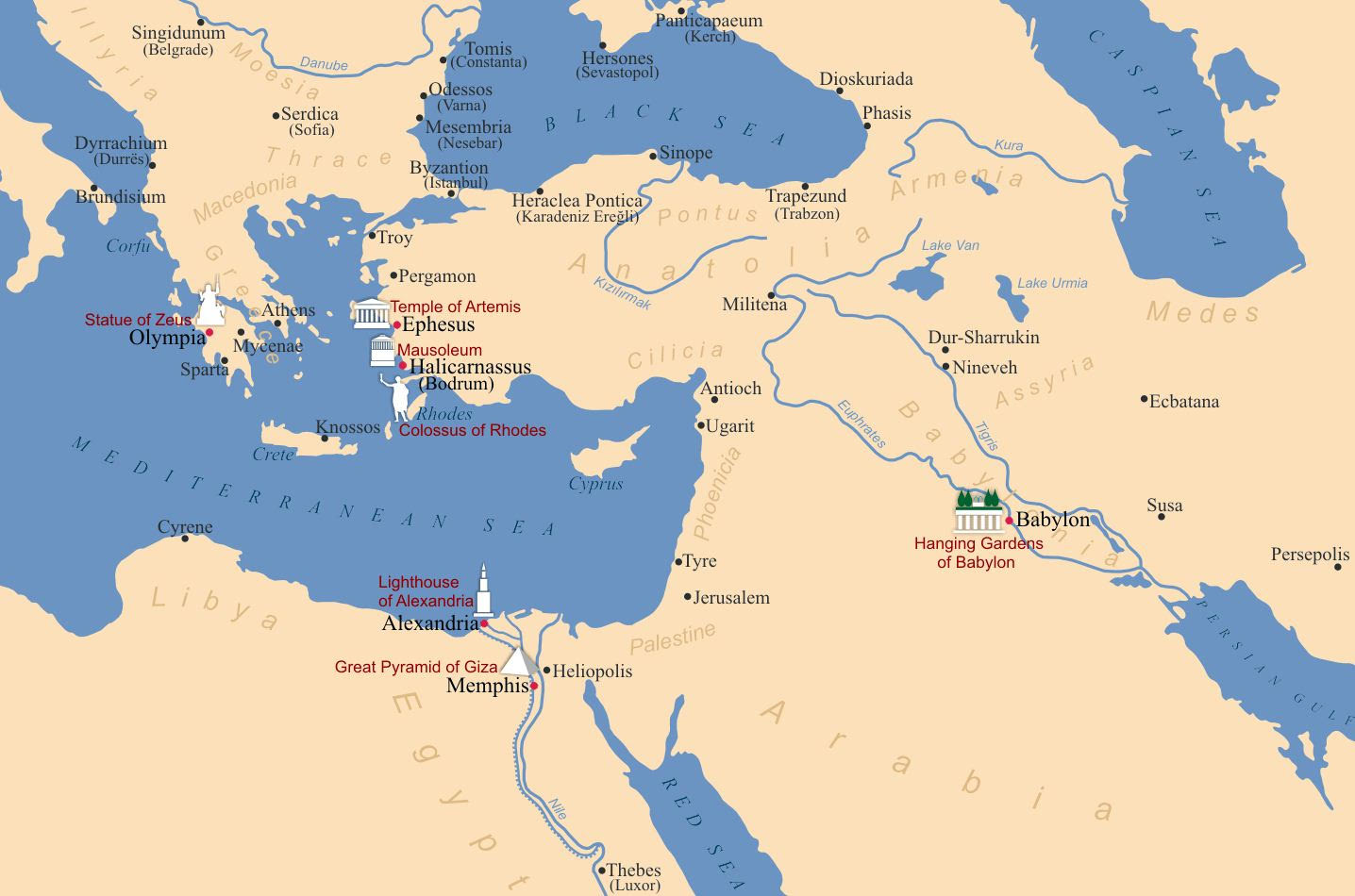
Map of the Seven Wonders (Wikimedia Commons)
To that point in time, Herodotus was the Lonely Planet guide of the day, but people didn’t necessarily want to travel. War with Persia made that a risky undertaking. But when the last embers of the Wars of Succession finally died and the world was safe again, there was mass movement of people and ideas. The list of the Seven Wonders could have been a wonderful itinerary, or at least a list of popular hotspots around the eastern Mediterranean.
It is no surprise that Philo was a mathematician inclined to mechanics and that Antipater was a poet. The Seven Wonders would have appealed to both men as monuments of inspiration that many could not even guess at how they were constructed.
Let’s have a brief look at this wonderful list of monuments.
I – The Pyramids of Giza
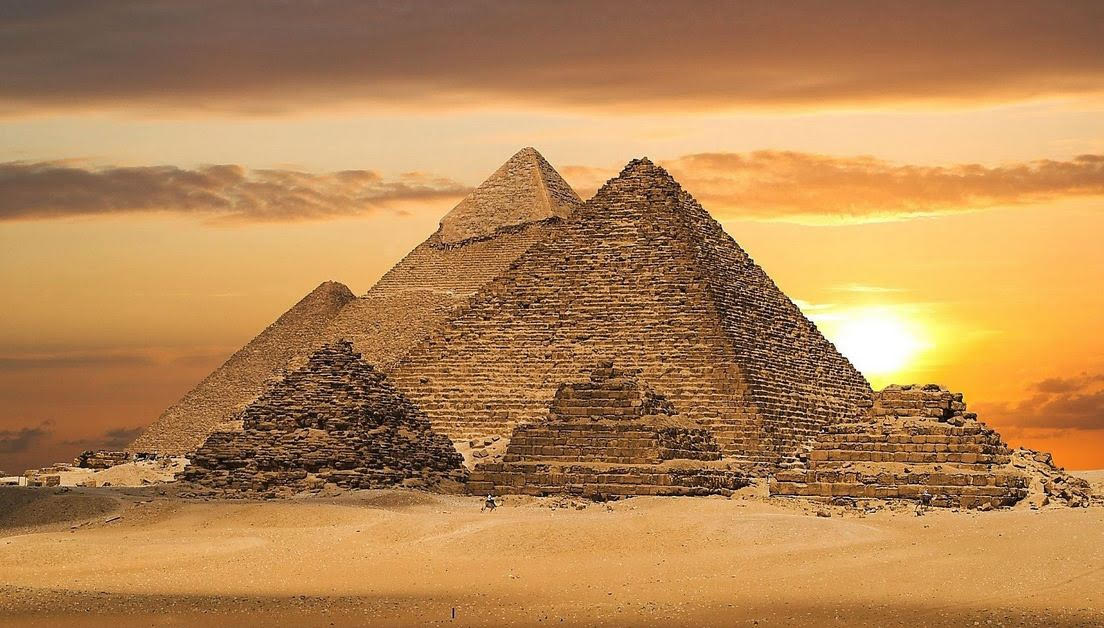
The Pyramids of Giza
It’s ironic, but the Pyramids of Giza which were built around 2,600 B.C. are the oldest monuments on the list, and yet they are the only ones that survive to this day. I had a chance once to go to Egypt on a dig but that was the year just after 9/11 and all hell had broken loose. The dig was cancelled. No matter how many times I see the pyramids on television, I can never get over their simple magnificence. And I’m sure they are even more striking in real life. As the last remaining wonder on the list, I hope I don’t miss out.
II – The Hanging Gardens of Babylon
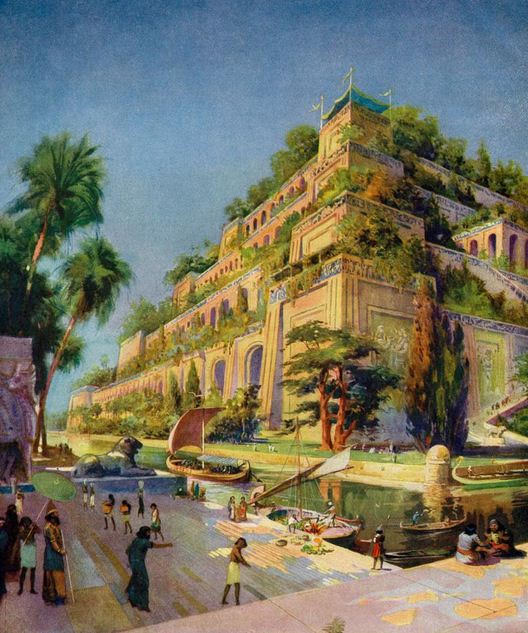
Then Hanging Gardens of Babylon
The hanging gardens of Babylon are interesting and their existence is still widely contested, the date of their possible building unknown. From what is said, the Hanging Gardens were created by Nebuchadnezzar II (ruled 605-562 B.C.) for his Median wife, Amytis who was homesick in that dry land. So, he is said to have built a sort of stepped pyramid with terraces that were covered with lush gardens of flowers and fruit trees. It is said there was a complex irrigation system for the entire gardens from top to bottom and that exotic animals roamed its heights. I don’t know if this is truth or fable, but I do know that this was supposed to be one of the most ancient civilizations on the planet. Here is what Quintus Curtius Rufus says about the Hanging Gardens:
“On its summit [of the Babylonian citadel] are the hanging gardens, a wonder celebrated by the fables of the Greeks. They are as high as the top of the walls and owe their charm to the shade of many tall trees. The columns supporting the whole edifice are built of rock, and on top of them is a flat surface of squared stones strong enough to bear the deep layer of earth placed upon it and the water used for irrigating it. So stout are the trees the structure supports that their trunks are eight cubits thick and their height as much as fifty feet; they bear fruit as abundantly as if they were growing in their natural environment… It has a substructure of walls twenty feet thick at eleven foot intervals, so that from a distance one has the impression of woods overhanging their native mountains.” (Quintus Curtius Rufus, The History of Alexander)
The rest of the monuments on the list from now on are Greek. No surprise since the compilers of the list were Greek. Nonetheless, these monuments are indeed deserving of ancient accolades.
III – Temple of Artemis at Ephesus
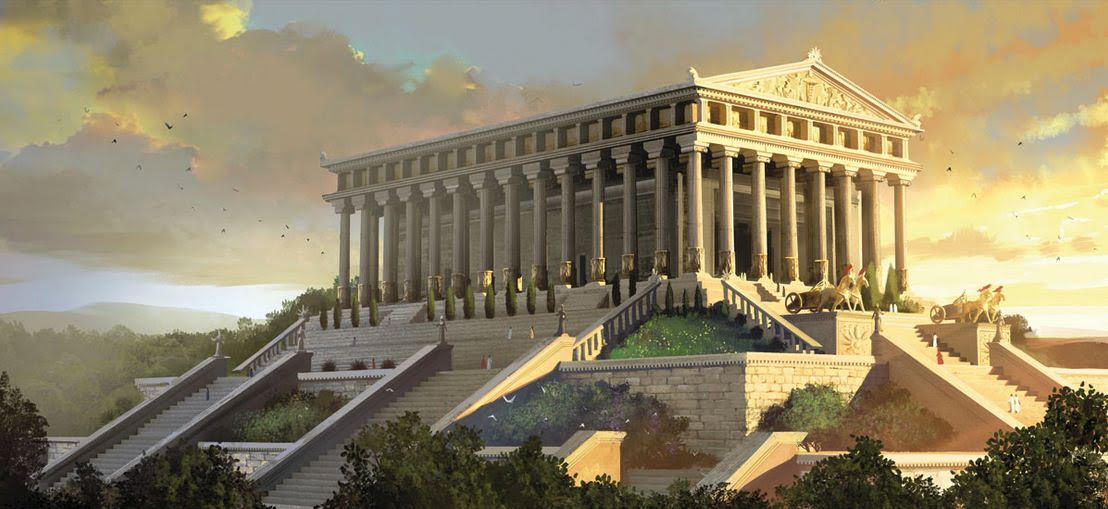
The Temple of Artemis
The Temple of Artemis at Ephesus, built in the sixth-century B.C. in what is now modern Turkey, was one of the largest, most beautiful temples of the ancient world. Its construction was paid for by the wealthy Lydian King, Croesus. It took ten years to build and brought pilgrims to Ephesus for centuries. The temple was said to be about 137 meters long, 69 meters wide and 18 meters high with more than 127 columns. Sadly, the temple was destroyed by raiding Goths in the third century A.D. However, the memory of the beauty of this temple to the Goddess of the Hunt would live on.
For Antipater of Sidon, it was the most beautiful of all the wonders:
“…when I saw the house of Artemis that mounted to the clouds, those other marvels lost their brilliancy, and I said, “Lo, apart from Olympus, the Sun never looked on aught so grand”.” (Antipater, Greek Anthology
IV – The Statue of Zeus, Olympia
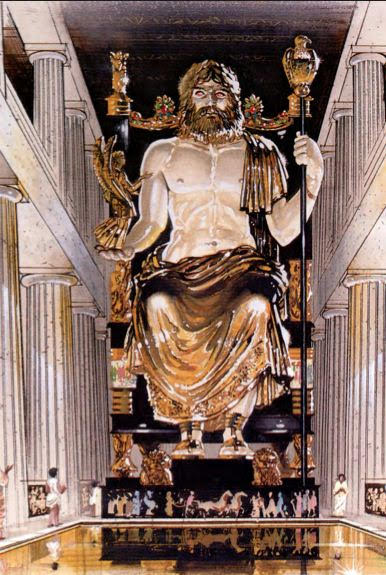
The Statue of Olympian Zeus, Olympia
Ancient Olympia is one of the few sites on this list that I have been fortunate enough to visit. I’ve been spending a lot of time there lately as I work my way through Heart of Fire. Ancient Olympia is one of my favourite sites in Greece, this peaceful, green sanctuary nestled between the rivers Alpheios and Kladeos in the eastern Peloponnese. Sadly, the twelve-meter, ivory and gold statue of Olympian Zeus was looted from the sanctuary long ago to fall victim to fire in another land.
However the fifth-century B.C. remains of the Temple of Zeus, which contained this wonder, still exist. So too does the workshop where the artist Pheidias laboured to shape the ivory that would create a giant, life-like representation of the king of the gods. The column drums of the temple now lie in domino lengths, grass-covered victims of earthquakes, and the workshop is bare and open to the sky. However, if you can make it there someday try standing on the paving slabs of the temple floor. Imagine the thick, Doric columns running the length of the interior to flank the giant statue of Zeus seated upon his throne. Then imagine how small a person must have felt in that space, the awe and the silence that resulted from being in the god’s presence.
V – The Mausuleum at Halicarnassus
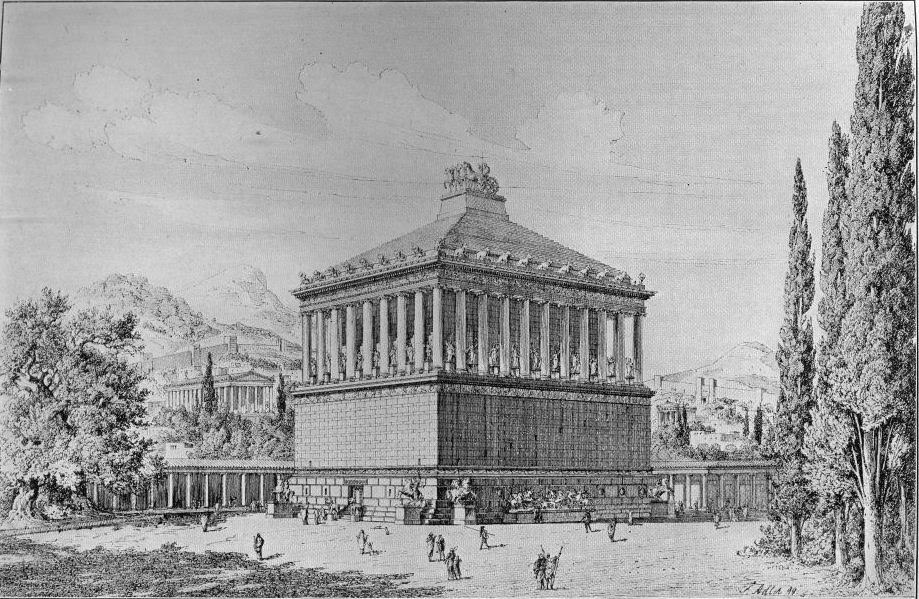
The Mausoleum of Halicarnassus
Back to Asia Minor now for the fifth of the Seven Wonders. Now we find ourselves in the ancient city of Halicarnassus, modern Bodrum, in Turkey. This was the site of the tomb of King Mausolus of Caria. The tomb, built in the mid-fourth century B.C., was not just any tomb. King Mausolus wanted to outdo all previous memorials, and so he commissioned the tomb by which all others would henceforth be measured.
King Mausolus’ ‘mausoleum’ was approximately 48 meters high and adorned top to bottom with the most beautiful, columns, reliefs and statuary of the day. The most talented artists and craftsmen of the Greek world were hired to work on it. It had statues of gods and goddesses, centaurs and lapiths, men and women, lions and other beasts. It rose into the sky to tower above Halicarnassus and to top it off was a massive four-horse chariot driven by Mausolus, with his wife Artemisia at his side. Mausolus never lived to see his tomb completed and so the task fell to Artemisia. But she died two years later. It is a testament to the craftsmen that they stayed to finished the mausoleum even then, after their patrons had gone into the afterlife.
VI – The Colossus of Rhodes

The Colossus of Rhodes
The island of Rhodes in the south-east Aegean is one of the larger Greek islands and a place of great beauty. It was said to have been the domain of the sun god, Helios. To commemorate the victory of Rhodes over Antigonous I of Cyprus, the Rhodians erected the Colossus between 292 and 280 B.C. The bronze statue of Helios was said to straddle the entrance to the harbour of Rhodes to a height of 33.5 meters, making it one of the tallest statues in the world, visible from far out at sea.
Today, if you visit Rhodes, it is the medieval city that really stands out to the visitor. The Colossus stood for only fifty-six years before it fell victim to an earthquake. It must have been an awe-inspiring sight while it stood. Now, the points where the feet of the statue were planted are marked by two pedestals at the harbour entrance. Though it did not stand for long, the influence of the Colossus of Rhodes lasted for ages, inspiring the Emperor Nero to erect his own colossus in Rome. A more modern version that was inspired by the Colossus is the French-built Statue of Liberty in New York, another beacon to guide and welcome travellers.
VII – The Pharos of Alexandria
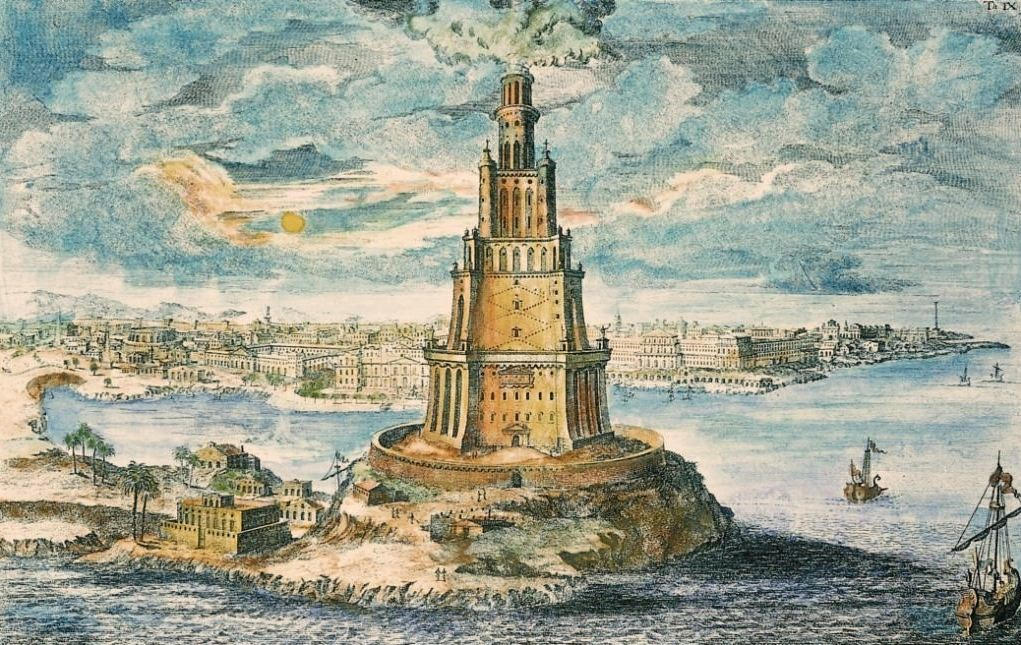
The Lighthouse, of ‘Pharos’, of Alexandria
The last structure on the list of the Seven Wonders was located in the most famous city founded by Alexander the Great: Alexandria. The Lighthouse, or ‘Pharos’, of Alexandria was built between 280 and 247 B.C. Some sources say it rose to a height of as much as 140 meters and that its reflected fires could been seen from unimaginable distances out at sea. The lighthouse guided ships into the city that had become the great metropolis of the world. For centuries the Pharos was the tallest structure in the world and was actually the third, longest-standing of the Seven Wonders after the Mausoleum and pyramids at Giza.
The great Lighthouse of Alexandria was truly a beacon to draw the world to one of the most advanced, civilized cities in existence.
In addition to being inspired by a look at the Seven Wonders of the Ancient World, I’m also a little saddened by it.
I think of what was, and what could have been, had they stood to this day (we’re fortunate indeed to have the Pyramids!). What would the world be like if we could still look upon the statue of Zeus at Olympia, or tour the Hanging Gardens of Babylon? Part of me thinks that it would be amazing to sail up to Rhodes beneath the gaze of the Colossus, or to walk the terraces of the Mausoleum gazing upon the statuary as upon an outdoor museum.
However, another part of me thinks that our modern world would ruin those things. I don’t want to imagine these once-brilliant monuments stained by exhaust and pollution, or surrounded by kiosks selling plastic souvenirs made in China. Would the names of countless tourists be scratched into the marble of the Temple of Artemis, or would the ankles of the Colossus be ringed with spray paint?
I think those things would be infinitely more painful than looking upon the ruins of these wonders and imagining what once was. These artistic and architectural wonders were more than just tourist attractions. The Seven Wonders of the Ancient World were, and are, markers in the timeline of human history, intended to inspire and to raise man from the dust so that the gods might catch a glimpse of those achievements, those offerings, and smile back with pride.
So, it may be that we no longer have these ancient treasures, just as we no longer have Hatra, Nineveh, Palmyra and others.
But we can certainly take heart from the Seven Wonders of the Ancient World. They may mostly be gone, but they will certainly never be forgotten.
Happy Holidays (whatever you are celebrating), and Happy Solstice to all of you.
Thank you for reading…
If you’re looking for something fascinating to watch over the holidays, be sure to check out this documentary by John Romer on the Seven Wonders of the Ancient World!
https://www.youtube.com/watch?v=ftw4xBgv9gI

Reblogged this on and commented:I don’t often rsepot, but these images strike a cord with me. They are elegant, almost classical, but express interesting concepts in a novel way.
It is a surprise to most people to learn that not all the Seven Wonders existed at the same time. Even if you lived in ancient times you would have still needed a time machine to see all seven. While the